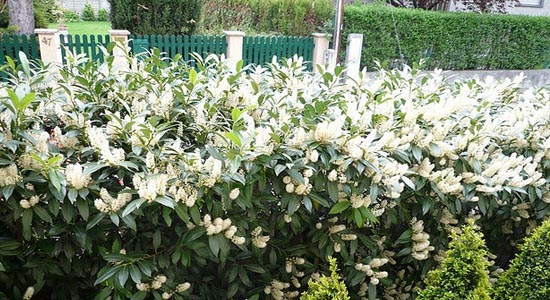Pruning cherry laurel – is it really necessary? Normally, the cherry laurel does not need pruning at all. Therefore, all those who have enough space should simply let it grow freely. However, if you lack the necessary space or you want to achieve a certain hedge shape, then you can not avoid cutting. We will explain to you how a hedge trimming works.
Contents
Pruning cherry laurel – best done by hand
Cherry laurel is simply another name for a shrub or tree whose proper name is laurel cherry. However, the plant has nothing to do with true laurel except for the similar leaf shape. As with all shrubs with large leaves, electric hedge shears should not be used for pruning. If the leaves are cut with such hedge shears, unsightly brown edges will form at the intersections.
When is it best to cut back?
It therefore makes more sense to cut the protruding leaves manually – by hand – with a sharp mechanical hedge trimmer. The optimal time for pruning is in the spring. Normally, the cherry laurel is pruned in April before the leaves shoot.
In principle, the cherry laurel is a robust plant – even severe pruning does not affect it. So if you want to make room and light for a large shrub, don’t hold back and take out a few stronger branches – the plant will grow back well. This is possible not only in spring but also in autumn.
Since leaves decompose very slowly, put prunings and old leaves in the organic waste garbage can and not in the compost. (What can be put on the compost, what not?).
Properly fertilize and water the laurel cherry.
The cherry laurel is popular not least because it is an evergreen plant that provides green privacy even in winter.
In addition, it is relatively undemanding in terms of location and soil. Nutrient-rich soils are to be preferred, insofar you support the plant on poor soils by adding compost or fertilizer, such as horn shavings or horn meal.
Make sure that the cherry laurel does not dry out, in dry summers, but also in winters with little rain water from time to time. However, waterlogging in very moist locations should be avoided.
Leaves and seeds are poisonous
The leaves and also the fruits and seeds of the bay cherry are poisonous; the glycosides they contain can release prussic acid in the stomach when eaten. For people, especially children, this can be life-threatening. However, the poison of the plant also affects animals such as cats, dogs or small animals.
If you want to have a natural garden, you should avoid cherry laurel or use it only very moderately. The plant is alien to our native nature, is avoided by animals, and offers no benefit to maintaining our biodiversity.
Not all cherry laurels are the same
Of course, there are many different varieties of the cherry laurel. One of the most popular representatives is Etna, partly because it is extremely hardy, grows very densely and thus provides the ideal visual and wind protection. In addition, Etna impresses its surroundings with exceptionally beautiful flowers.










